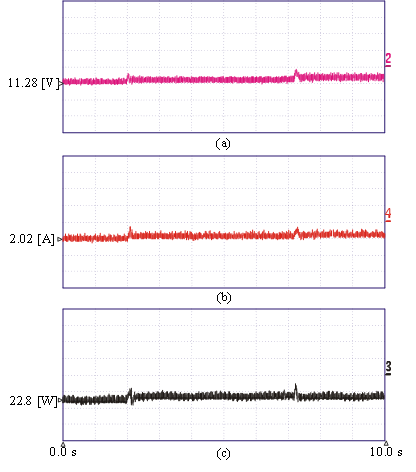Hybrid Artificial Bee Colony and incremental conductance—Algorithm for enhanced MPPT in photovoltaic systems
DOI:
https://doi.org/10.18686/cest335Keywords:
photovoltaic systems; maximum power point tracking; Artificial Bee Colony algorithm; incremental conductance; hybrid optimization techniques; hybrid MPPT algorithmsAbstract
The growing global demand for electricity necessitates efficient renewable energy solutions, with photovoltaic (PV) systems emerging as a prominent candidate. This study presents a novel hybrid Maximum Power Point Tracking (MPPT) algorithm that integrates the Artificial Bee Colony (ABC) optimization method with the Incremental Conductance (IC) technique, ensuring 100% accurate identification of the Global Maximum Power Point (GMPP) under partial shading conditions. Unlike standalone MPPT methods, the proposed approach leverages the exploratory capabilities of ABC for global search while utilizing IC for fast and precise tracking, achieving a convergence time of 0.37 s and minimal power oscillations of 2.7%. Experimental validation demonstrates the algorithm’s superior performance, attaining 100% efficiency, significantly outperforming standalone IC (74%) and ABC (99.5%) methods. The hybrid ABC-IC algorithm consistently tracks the GMPP, delivering 60 W under optimal irradiation (1000 W/m2) and surpassing conventional techniques such as P&O, FA, and PSO in terms of convergence speed, robustness, and adaptability to dynamic shading conditions. This innovative integration of bio-inspired and deterministic MPPT strategies offers a highly efficient and reliable solution for maximizing PV energy harvesting in real-world environments.

Downloads
Published
How to Cite
Issue
Section
License
Copyright (c) 2025 Author(s)

This work is licensed under a Creative Commons Attribution 4.0 International License.
References
1. Almutairi A, Abo-Khalil AG, Sayed K, et al. MPPT for a PV Grid-Connected System to Improve Efficiency under Partial Shading Conditions. Sustainability. 2020; 12(24): 10310. DOI: https://doi.org/10.3390/su122410310
2. de Brito MAG, Galotto L, Sampaio LP, et al. Evaluation of the main MPPT techniques for photovoltaic applications. IEEE Transactions on Industrial Electronics. 2013; 60(3): 1156–1167. DOI: https://doi.org/10.1109/TIE.2012.2198036
3. Premkumar M, Sumithira TR, Sowmya R. Implementation of Solar PV Based Microconverter with Optimal Mppt Control. J. Electr. Eng. 2108; 18(2): 1–12.
4. Pakkiraiah B, Sukumar GD. Research Survey on Various MPPT Performance Issues to Improve the Solar PV System Efficiency. J. Sol. Energy. 2016; 2016(6): 1–20. DOI: https://doi.org/10.1155/2016/8012432
5. Jately V, Bhattacharya S, Azzopardi B, et al. Voltage and Current Reference Based MPPT Under Rapidly Changing Irradiance and Load Resistance. IEEE Trans. Energy Convers. 2021; 36: 2297–2309. DOI: https://doi.org/10.1109/TEC.2021.3058454
6. Hohm DP, Ropp ME. Comparative study of maximum power point tracking algorithms. Progress in Photovoltaics: Research and Applications. 2003; 11(1): 47–62. DOI: https://doi.org/10.1002/pip.459
7. Ahmed J, Salam JZ. An enhanced adaptive P&O MPPT for fast and efficient tracking under varying environmental condition. IEEE Transactions on Sustainable Energy. 2018; 9(3): 1487–1496. DOI: https://doi.org/10.1109/TSTE.2018.2791968
8. Elgendy MA, Zahawi B, Atkinson DJ. Assessment of perturb and observe MPPT algorithm implementation techniques for PV pumping applications. IEEE Trans. Sustain. Energy. 2012; 3: 21–33. DOI: https://doi.org/10.1109/TSTE.2011.2168245
9. Masood B, Siddique MS, Asif RM, et al. Maximum power point tracking using hybrid perturb & observe and incremental conductance techniques. In: Proceedings of the 4th International Conference on Engineering Technology and Technopreneuship (ICE2T); 27–29 August 2014; Kuala Lumpur, Malaysia. DOI: https://doi.org/10.1109/ICE2T.2014.7006277
10. Safari A, Mekhilef S. Incremental conductance MPPT method for PV systems. In: Proceedings of the 24th Canadian Conference on IEEE; 8–11 May 2011; Niagara Falls, ON, Canada. pp. 345–347. DOI: https://doi.org/10.1109/CCECE.2011.6030470
11. Hussein KH, Muta I, Hoshino T, et al. Maximum Photovoltaic Power Tracking: an Algorithm for Rapidly Changing Atmospheric Conditions. IEE Proceedings-Generation, Transmission and Distribution. 1995; 142(1): 59–64. DOI: https://doi.org/10.1049/ip-gtd:19951577
12. Sharma A, Sharma A, Jately V, et al. A Novel TSA-PSO Based Hybrid Algorithm for GMPP Tracking under Partial Shading Conditions. Energies. 2022; 15: 3164. DOI: https://doi.org/10.3390/en15093164
13. Elhaddad, Y. Combined Simulated Annealing and Genetic Algorithm to Solve Optimization Problems. World Academy of Science, Engineering and Technology. 2012; 6: 1047–1049.
14. Long W, Xu S. A novel grey wolf optimizer for global optimization. In: Proceedings of the IEEE Advanced Information Management, Communicates, Electronic and Automation Control Conference (IMCEC); 3–5 October 2016; Xi’an, China. pp. 1266–1270. DOI: https://doi.org/10.1109/IMCEC.2016.7867415
15. Mirjalili S, Mohammad S, Lewis A. Grey Wolf Optimizer. Advances in Engineering Software. Elsevier. 2014; 69: 46–61. DOI: https://doi.org/10.1016/j.advengsoft.2013.12.007
16. Sundareswaran K, Vigneshkumar V, Sankar P, et al. Development of an Improved P&O Algorithm Assisted Through a Colony of Foraging Ants for MPPT in PV System. IEEE Transactions on Industrial Informatics. 2016; 12(1). pp. 187–200. DOI: https://doi.org/10.1109/TII.2015.2502428
17. Oshaba S, Ali ES, Abd Elazim SM. Artificial bee colony algorithm based maximum power point tracking in photovoltaic system. WSEAS Trans. Power Syst. 2015; 10: 123–134
18. Qi P, Xia H, Cai X, et al. Novel Global MPPT Technique Based on Hybrid Cuckoo Search and Artificial Bee Colony under Partial-Shading Conditions. Electronics. 2024; 13(7): 1337. DOI: https://doi.org/10.3390/electronics13071337
19. Kaya CB, Kaya E, Gökkuş G. Training Neuro-Fuzzy by Using Meta-Heuristic Algorithms for MPPT. Computer Systems Science & Engineering. 2023; 45(1). DOI: https://doi.org/10.32604/csse.2023.030598
20. Kishore DK, Mohamed MR, Sudhakar K, et al. Swarm intelligence-based MPPT design for PV systems under diverse partial shading conditions. Energy. 2023; 265: 126366. DOI: https://doi.org/10.1016/j.energy.2022.126366
21. Silaa MY, Barambones O, Bencherif A, et al. A New MPPT-Based Extended Grey Wolf Optimizer for Stand-Alone PV System: A Performance Evaluation versus Four Smart MPPT Techniques in Diverse Scenarios. Inventions. 2023; 8(6): 142. DOI: https://doi.org/10.3390/inventions8060142
22. Ibrahim MH, Ang SP, Dani MN, et al. Optimizing step-size of perturb & observe and incremental conductance MPPT techniques using PSO for grid-tied PV system. IEEE access. 2023; 11: 13079–13090. DOI: https://doi.org/10.1109/ACCESS.2023.3242979
23. Naoussi SRD, Saatong KT, Molu RJJ, et al. RETRACTED ARTICLE: Enhancing MPPT performance for partially shaded photovoltaic arrays through backstepping control with Genetic Algorithm-optimized gains. Scientific Reports. 2024; 14(1): 3334. DOI: https://doi.org/10.1038/s41598-024-53721-w
24. Abouzeid AF, Eleraky H, Kalas A, et al. Experimental validation of a low-cost maximum power point tracking technique based on artificial neural network for photovoltaic systems. Scientific Reports. 2024; 14(1): 18280. DOI: https://doi.org/10.1038/s41598-024-67306-0
25. Ncir N, El Akchiou N. An advanced intelligent MPPT control strategy based on the imperialist competitive algorithm and artificial neural networks. Evolutionary Intelligence. 2024; 17(3): 1437–1461. DOI: https://doi.org/10.1007/s12065-023-00838-y
26. Gul S, Malik SM, Sun Y, et al. An artificial neural network based MPPT control of modified flyback converter for PV systems in active buildings. Energy Reports. 2024; 12: 2865–2872. DOI: https://doi.org/10.1016/j.egyr.2024.08.082
27. Colbu ŞC, Băncilă DM, Petrescu-Niţă A, et al. A comparative study of support vector machine and risk deterministic approach on a photovoltaic system. UPB Sci. Bull., Series C. 2024; 86(3): 67–80.
28. Kumar P, Viswambharan VK, Pillai S. Performance Analysis of Maximum Power Point Tracking of PV Systems using Artificial Neural Networks and Support Vector Machines. In: Proceedings of the 2023 International Conference on Computational Intelligence and Knowledge Economy (ICCIKE); 9–10 March; Dubai, UAE. pp. 511–515. DOI: https://doi.org/10.1109/ICCIKE58312.2023.10131783
29. Ahmed QI, Attar H, Amer A, et al. Development of a hybrid support vector machine with grey wolf optimization algorithm for detection of the solar power plants anomalies. Systems. 2023; 11(5): 237. DOI: https://doi.org/10.3390/systems11050237
30. Ghazi GA, Al-Ammar EA, Hasanien HM, et al. Dandelion optimizer-based reinforcement learning techniques for MPPT of grid-connected photovoltaic systems. IEEE Access. 2024; 12: 42932–42948. DOI: https://doi.org/10.1109/ACCESS.2024.3378749
31. Leelavathi M, Suresh KV. Enhancing MPPT in partially shaded PV modules: A novel approach using adaptive reinforcement learning with neural network architecture. Bulletin of the Polish Academy of Sciences. Technical Sciences. 2024; 72(4). DOI: https://doi.org/10.24425/bpasts.2024.150112
32. Kumar D, Chauhan YK, Pandey AS, et al. A novel hybrid MPPT approach for solar PV systems using particle-swarm-optimization-trained machine learning and flying squirrel search optimization. Sustainability. 2023; 15(6): 5575. DOI: https://doi.org/10.3390/su15065575
33. Bouchakour A, Zarour L, Bessous N, et al. MPPT algorithm based on metaheuristic techniques (PSO & GA) dedicated to improve wind energy water pumping system performance. Scientific Reports. 2024; 14(1): 17891. DOI: https://doi.org/10.1038/s41598-024-68584-4
34. Sree VS, Ankarao M. Power quality enhancement of solar–wind grid connected system employing genetic-based ANFIS controller. Paladyn J. Behav. Robotics. 2023; 14(1). DOI: https://doi.org/10.1515/pjbr-2022-0116
35. Ghilani A, Terki A, Alili Z, et al. Experimental Validation of PSO and GWO-Based MPPT for a Single-Stage Three-Phase Grid-Connected PV System Under Partial Shading. Journal Européen des Systèmes Automatisés. 2024; 57(5): 1387. DOI: https://doi.org/10.18280/jesa.570514
36. Jia D, Wang D. A Maximum Power Point Tracking (MPPT) Strategy Based on Harris Hawk Optimization (HHO) Algorithm. Actuators. 2024; 13(11): 431. DOI: https://doi.org/10.3390/act13110431
37. Tao X, Xin J, Zhang S, et al. A Novel Harris-Hawk-Optimization-Based Maximum-Power-Point-Tracking Control Strategy for a Grid-Connected PV Power-Generation System. Energies. 2023; 17(1): 76. DOI: https://doi.org/10.3390/en17010076
38. Abdelmalek F, Afghoul H, Krim F, et al. Experimental validation of novel hybrid Grey Wolf Equilibrium Optimization for MPPT to improve the efficiency of solar photovoltaic system. Results in Engineering. 2025; 25: 103831. DOI: https://doi.org/10.1016/j.rineng.2024.103831
39. KT S, Venugopal Reddy B. A novel constraint‐based improved equilibrium optimization for global peak tracking of photovoltaic system under complex shading conditions. International Journal of Circuit Theory and Applications. 2023; 51(6): 2819–2838. DOI: https://doi.org/10.1002/cta.3546
40. Abo-Khalil AG, Lee DC, Choi JW, et al. Maximum Power Point Tracking Controller Connecting PV System to Grid. Korean Institute of Power Electronics Journal. 2006; 6(3).
41. Syafaruddin, Karatepe E, Hiyama T. Artificial neural network-polar coordinated fuzzy controller based maximum power point tracking control under partially shaded conditions. IET Renewable Power Generation. 2009; 3(2): 239–253. DOI: https://doi.org/10.1049/iet-rpg:20080065
42. Veerachary M, Senjyu T, Uezato K. Neural-network-based maximum-power-point tracking of coupled-inductor interleaved-boost converter-supplied PV system using fuzzy controller. IEEE Trans. Ind. Electron. 2023; 50(4): 749–758. DOI: https://doi.org/10.1109/TIE.2003.814762
43. Eltamaly AM, Al-Saud MS, Abo-Khalil AG, et al. Simulation and Experimental Validation of Fast Adaptive Particle Swarm Optimization Strategy for Photovoltaic Global Peak Tracker under Dynamic Partial Shading. Renewable & Sustainable Energy Reviews. 2020; 124: 109719. DOI: https://doi.org/10.1016/j.rser.2020.109719
44. Eltamaly AM, Al-Saud MS, Abo-Khalil AG. Performance Improvement of PV Systems’ Maximum Power Point Tracker Based on a Scanning PSO Particle Strategy. Sustainability. 2020; 12(3): 1185. DOI: https://doi.org/10.3390/su12031185
45. Putri RI, Wibowo S, Rifa’i M. Maximum power point tracking for photovoltaic using incremental conductance method. Energy Procedia. 2015; 68: 22–30. DOI: https://doi.org/10.1016/j.egypro.2015.03.228
46. Chao RM, Nasirudin A, Wang IK, Chen PL. Multicore PSO operation for maximum power point tracking of a distributed photovoltaic system under partially shading condition. Int. J. Photoenergy. 2016; 2016: 9754514. DOI: https://doi.org/10.1155/2016/9754514
47. Eltamaly AM, Al-Saud MS, Abo-Khalil AG. Photovoltaic maximum power point tracking under dynamic partial shading changes by novel adaptive particle swarm optimization strategy. Transactions of the Institute of Measurement and Control. 2019. DOI: https://doi.org/10.1177/0142331219865627
48. Abo-Khalil AG. Maximum Power Point Tracking for a PV System Using Tuned Support Vector Regression by Particle Swarm Optimization. Journal of Engineering Research. 2020; 8(4): 139–152. DOI: https://doi.org/10.36909/jer.v8i4.9113
49. Pilakkat D, Kanthalakshmi S. An improved P&O algorithm integrated with artificial bee colony for photovoltaic systems under partial shading conditions. Sol. Energy. 2019; 178: 37–47. DOI: https://doi.org/10.1016/j.solener.2018.12.008
50. Eltamaly M, Al-Saud MS, AboKhalil AG. A Novel Bat Algorithm Strategy for Maximum Power Point Tracker of Photovoltaic Energy Systems Under Dynamic Partial Shading. IEEE Access. 2020; 8: 10048–1006. DOI: https://doi.org/10.1109/ACCESS.2020.2964759
51. Harrag A, Messalti S. Variable step size modified P&O MPPT algorithm using GA-based hybrid offline/online PIDcontroller. Renewable and Sustainable Energy Reviews. 2015; 49: 1247–60.
52. Seyedmahmoudian M, Rahmani R, Mekhilef S, et al. Simulation and hardware implementation of new maximum power point tracking technique for partially shaded PV system using hybrid DEPSO method. IEEE Transactions on Sustainable Energy. 2015; 6: 850–862. DOI: https://doi.org/10.1109/TSTE.2015.2413359
53. Eltamaly AlM, Farh HMH, Abokhalil AG. A novel PSO strategy for improving dynamic change partial shading photovoltaic maximum power point tracker. Energy Sources, Part A: Recovery, Utilization, and Environmental Effects. 2020; 46(4): 1–15. DOI: https://doi.org/10.1080/15567036.2020.1769774
54. Farh HMH, Othman MF, Eltamaly AM, et al. Maximum power extraction from a partially shaded PV system using an interleaved boost converter. Energies. 2018; 11(10): 2543. DOI: https://doi.org/10.3390/en11102543
55. Harrag A, Messalti S. Variable step size modified P&O MPPT algorithm using GA-based hybrid offline/online PID controller. Renewable and Sustainable Energy Reviews. 2015; 49: 1247–1260. DOI: https://doi.org/10.1016/j.rser.2015.05.003
56. Abo-Khalil AG, Yu GY. Current Estimation-based Maximum Power Point Tracker of Grid Connected PV. In: Proceedings of the IEEE 10th International Conference on Power Electronics and Drive Systems (PEDS); 22–25 April 2013; Kitakyushu, Japan.
57. Yang XS. Chaos-enhanced firefly algorithm with automatic parameter tuning. International Journal of Swarm Intelligence Research. 2011; 2(4) 1–11. DOI: https://doi.org/10.4018/jsir.2011100101
58. Yang XS. A new metaheuristic bat-inspired algorithm. In: Cruz C, González JR, Gonzalez JR. (editors). Nature Inspired Cooperative Strategies for Optimization (NICSO 2010). Springer; 2010. Volume 284. pp. 65–74. DOI: https://doi.org/10.1007/978-3-642-12538-6_6
59. Yang XS. Firefly algorithm, stochastic test functions and design optimization. International Journal of Bio-Inspired Computation. 2010; 2(2): 78–84. DOI: https://doi.org/10.1504/IJBIC.2010.032124
60. Bilal B. Implementation of artificial bee colony algorithm on maximum power point tracking for PV modules. In: Proceedings of the 8th International Symposium on Advanced Topics in Electrical Engineering (ATEE); 23–25 May 2013; Bucharest, Romania. DOI: https://doi.org/10.1109/ATEE.2013.6563495
61. Abo-Khalil AG, Alharbi W, Al-Qawasmi AR, et al. Maximum Power Point Tracking of PV Systems under Partial Shading Conditions Based on Opposition-Based Learning Firefly Algorithm. Sustainability. 2021; 13(5): 2656. DOI: https://doi.org/10.3390/su13052656
62. Abo-Khalil AG, El-Sharkawy II, Radwan AM, et al. Influence of a Hybrid MPPT Technique, SA-P&O, on PV System Performance under Partial Shading Conditions. Energies. 2023; 16(2): 577. DOI: https://doi.org/10.3390/en16020577




.jpg)
.jpg)

